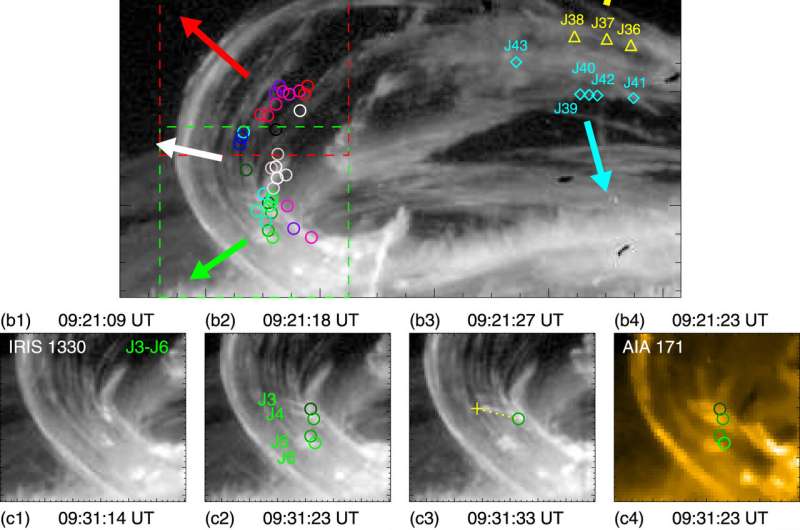Small-scale UV jets in an activated tornado-like prominence observed by spacecraft IRIS and SDO. Credit: CHEN Huadong
Solar jets are a common phenomenon in the solar atmosphere. They mainly appear as transient collimated plasma ejections. Some studies have shown that jets may play an important role in heating the corona and initiating solar winds.
Dr. Chen Huadong from the National Astronomical Observatories of Chinese Academy of Sciences (NAOC) and his collaborators first found a particular type of small-scale jets, which arose singly or in clusters from a tornado-like prominence suspended in the corona, according to the study published in the Astrophysical Journal Letters in 2017.
The difference in the local plasma environment and magnetic field topology structure between these coronal mini-jets and the other jets previously reported suggests that they may have different formation mechanisms.
Recently, an international research team led by Dr. Chen Huadong further conducted a statistical analysis of the dynamical and energetic characteristics of the coronal mini-jets, and proposed two possible fine-scale magnetic reconnection mechanisms to explain the occurrence of the jets. The study was published in the Astrophysical Journal on August 7.
According to their results, magnetic reconnection probably takes place between the prominence field and the enveloping or background field. The enveloping field means the magnetic field closely enveloping the erupting prominence. The background field mainly refers to the potential field in the active region. This reconnection can be called external reconnection.
Through the physical process of magnetic reconnection, magnetic energy can be converted into thermal and kinetic energy, which would heat and accelerate the plasma of the prominence to move along the enveloping or background field to form the jets.
Additionally, solar tornado-like prominence usually has complex magnetic field structures. So magnetic reconnection may also occur between twisted or braided flux tubes within the prominence. This kind of reconnection can be named internal reconnection. Similarly, internal reconnection would also heat and accelerate the prominence mass to erupt in directions approximately perpendicular to the flux rope.
"Since this event occurs near the solar limb, nonlinear force-free field extrapolations cannot be employed to help clarify the spatial relationship of the prominence field to its surrounding non-potential field. The role of the two mechanisms in formation of similar coronal mini-jets still needs more research work to confirm in the future," said Dr. Chen.
One referee commented, "This study presents an important new fine-scale explosive solar phenomenon. Because these mini-jets are presumably produced by fine-scale bursts of magnetic reconnection, they open a new empirical window on the reconnection process in filament eruptions."
More information: Huadong Chen et al. Coronal Mini-jets in an Activated Solar Tornado-like Prominence, The Astrophysical Journal (2020). DOI: 10.3847/1538-4357/ab9cad
Journal information: Astrophysical Journal Letters , Astrophysical Journal
Provided by Chinese Academy of Sciences
























